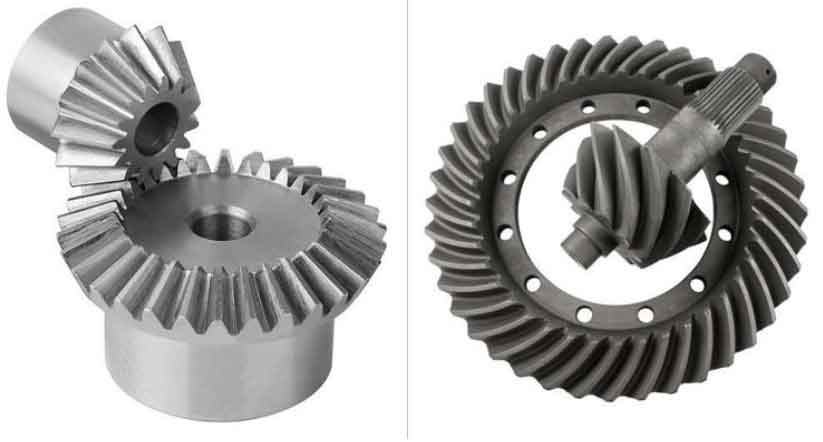
Straight bevel gears and spiral bevel gears are two common types of bevel gears used for power transmission between non-parallel shafts. While they share similarities in their fundamental function, there are distinct differences in their gear designs and performance characteristics. Let’s compare straight bevel gears and spiral bevel gears:
1. Tooth Profile:
- Straight Bevel Gears: Straight bevel gears have straight teeth cut along the conical surface of the gear. The teeth are in a simple straight line.
- Spiral Bevel Gears: Spiral bevel gears have curved teeth that are cut in a spiral pattern around the gear’s conical surface. The spiral pattern allows for gradual tooth engagement and disengagement, resulting in smoother and quieter operation compared to straight bevel gears.
2. Contact Pattern:
- Straight Bevel Gears: The contact between the teeth of straight bevel gears is at a single point along the tooth face. This point contact can lead to concentrated stresses and higher wear, especially under heavy loads.
- Spiral Bevel Gears: Spiral bevel gears have a larger contact area between teeth due to their curved tooth profile. This distributes the load more evenly, reducing stress concentrations and wear.
3. Noise and Vibration:
- Straight Bevel Gears: Straight bevel gears can produce more noise and vibration during operation compared to spiral bevel gears, mainly due to the point contact of their teeth.
- Spiral Bevel Gears: Spiral bevel gears offer smoother engagement and quieter operation, making them preferred for applications where noise reduction is important, such as automotive transmissions.
4. Load Capacity:
- Straight Bevel Gears: Straight bevel gears have good load-carrying capacity but may not handle as high a load as spiral bevel gears due to the concentrated contact point.
- Spiral Bevel Gears: Spiral bevel gears have a higher load-carrying capacity due to the larger contact area and gradual tooth engagement.
5. Precision and Accuracy:
- Straight Bevel Gears: Straight bevel gears are relatively easier to manufacture and may be more cost-effective for some applications.
- Spiral Bevel Gears: Spiral bevel gears require more precise manufacturing due to their curved tooth profile, making them suitable for high-precision applications.
6. Applications:
- Straight Bevel Gears: Straight bevel gears are commonly used in applications where shafts intersect at a 90-degree angle, such as hand drills, machine tools, and some automotive differentials.
- Spiral Bevel Gears: Spiral bevel gears are preferred in applications requiring high precision, higher speed, and smoother operation, such as automotive transmissions, aircraft systems, and industrial machinery.
Straight bevel gears are suitable for simpler applications where noise and precision requirements are less critical. On the other hand, spiral bevel gears offer improved performance, quieter operation, and better load-carrying capabilities, making them ideal for precision motion control systems and applications where efficiency and smooth operation are paramount. The selection between straight bevel gears and spiral bevel gears depends on the specific requirements of the application and the desired performance characteristics.
